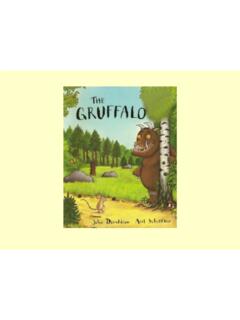Transcription of outdoor lea rning pack - Woodland Trust
1 Outdoorlearningpackfor primary school teachers in Scotland,England, Northern Ireland and Waleswhy teachoutdoo rs?A real-world context for learning Learning in a real context can turn the abstract into the concrete. It inspires curiosityand investigation which inspire enquiring minds and enables them to achieve. The classroom of the future should not be limited to a classroom at all an excellent curriculum would go beyond the traditional boundaries and offer real-world learning experiences outdoors. Taking Learning Outdoors LTS 2007>More about why outdoor learning is importantOutdoor Learning Grounds for Learning learning complements indoor learning Recent studies show that the outdoors is a dynamic environment that stimulatescreativity and enables learning to happen faster.
2 Hands-on = minds-on!Supports emotional and physical well-being Fresh air and open space obviously promote physical activity but the impact of greenspaces on mental health is just as knowledge of and care for the natural environment Regular direct contact with the natural world builds deep connections that last a lifetime. How can we expect people to care about something they don t know?Impacts positively on attitudes and self-esteemChildren feel free to be themselves outside of the constraints of the who struggle to concentrate indoors often blossom outside, where theirkinaesthetic learning needs can be addressed more (clockwise) Helen Pugh Photography, WTPL/ Jo Mugford, Kate Walters, WTPL/ Victor DeJesus, Kate WaltersindexThe type of outdoor learning described in this pack is something quite different from outdoor pursuits.
3 It is not rock-climbing or kayaking. It is about taking your normal everyday curriculum and teaching it outside. The outdoor areas you use could be very closeto the school and within walking distance it might be the school grounds, a local park or anearby patch of Woodland . So, no long bus journey, no cost and no high-risk activity!1 Getting Outside the Classroom2 Feeling at Home in the outdoor Classroom 3 Making outdoor Teaching Easier4 Longridge Primary School Case Study (Part 1)5 Longridge Primary School Case Study (Part 2)6 Starting in the Classroom7 Starting in the Classroom8 Getting (and back again!)
4 9 Getting (and back again!) 10 Getting to Know the Trees11 Animal Homes12 Minibeasts in Your Trees13 Numeracy14 Literacy15 Art or Science?16 Wild Art17 Word Art18 Evaluation19 Assessment for Learning20 Follow-up Opportunities21 Gaelic & Modern Language Tree Names22 outdoor Classroom Resources23 outdoor Classroom Risk Assessment24 Daily Hazard Tick ListThis pack is a result of working closely with primary school teachers in West Lothian, Scotland, who arededicated to removing barriers to using the outdoor classroom. Thanks go to all the teachers and schoolswho have contributed to this work through their time, expertise and honesty.
5 >Approaches to outdoor learning include Earth Education by Steve Van Matre Flow Learningby Joseph LEARNING PACKPage 1getting outside the classroomPlanning an outdoor lesson is done in the same way as inside the classroom:>Introduction(hook):introduce the topic in the classroom with an activity that promotes interest and intrigue in what is to come (see page 6/7)>Journey Out(starter):simple, hands-on ambulatory activities create the right mood within the group for learning outdoors, whilst also raising awareness of the natural environmentand introducing the main topic (see pages 8/9)>Main Activity(development): a hub activity is just like a carpet activity indoors, where you ask the group to spread out from a central point to do the activity and then return to you at the end (see pages 10 17)>Reflection/Sharing(evaluation/assess ment):give the children a chance to share with others the things they have learned or achieved.
6 It s also an opportunity to evaluate the learning and challenge any misperception (see page 18/19)>Journey Back(plenary): reinforce learning on the walk back to school (see page 8/9) andthen follow-up in the classroom (see page 20)feeling at home in the outdoor classroomIndoorOutdoorNotesWallsSet clear physical boundaries Plan your route and know where you will have space to stop and circle up the class. Visualise your own boundaries and then define the edges of your teaching area verbally or using physical markers ( tie tape around some trees).Emergency Emergency proceduresAgree a meeting point and what to do.
7 Ensure all staff and children are awareprocedures ( fire)( missing person)of these. Know where the access points would be for emergency vehicles. Chairs & tablesSit-mats on the ground Stops shuffling feet!Prepared paper materials Found natural materialsTwigs, fallen leaves, stones, earth, the list is endless!! WarmthWarmthGet a bank of clothing in school buy waterproofs, wellies and warm gear or ask(radiators)(appropriate clothing)for parents to donate old articles of aid kitFirst aid kitBe aware of any relevant medical information tree nut allergies, hayfever etc.
8 Take a rucksack with: First aid kit, water, mobile phone (check reception), emergency contact numbers (inc. all adult helpers mobile numbers in case groups separate), risk assessment and hazard tick list (pages 23 & 24 of this pack).Risk assessed & managed Risk assessed & managedAs usual for off-site visits risk assess site, route and activity beforehand. Complete last minute hazard tick list on the day as a final check. Check your schools child:adult lessonsPlanned lessons & routesGood planning is the (away from water Ensure children are prepared; that they know how long they will be out and that source & working area)there will be NO TOILETS!
9 !Agreed expectations Agreed expectations Setting expectations together beforehand will increase enjoyment for yougolden rules & procedures golden rules & procedures and your class. Involve other staff as well as the ratios = lowStaff ratios = higherGet supportive parents on board as with the children, this will engage some that indoor teaching doesn t. As usual, ensure they are checked through PVGor DBS page 18 of this pack for Assessment See page 19 of this pack for for rewarding Strategies for rewarding Be clear about how you will respond to all behaviours to ensure consistencyand managing behaviour and managing behaviourand fairness.
10 Share your strategy with other adults as well the nearbyMobile phone or Know where you have good signal coverage on site and where emergency2-way radiosvehicle access points are (including street name or grid ref).Closed, predictable Open environmentGood planning and pre-visits to site will make things more predictable .environment Don t be afraid to let things be child- or nature-led!Children s parents and Children s parents andTaking the class outdoors may make some parents and adults feel unsure. teaching assistants teaching assistants Address their fears and reassure them by holding a meeting to explain why feel uncomfortablefeel uncomfortablethe school feels it is important.



